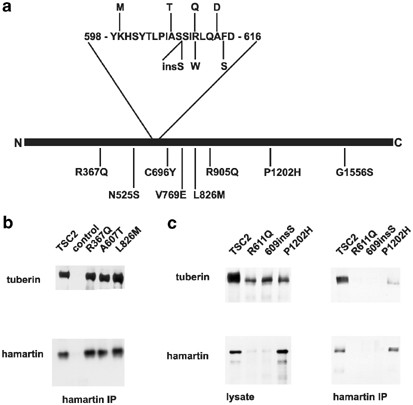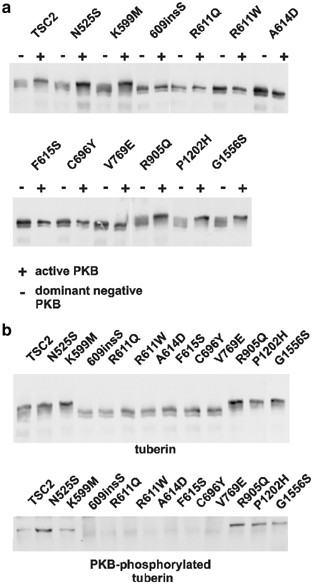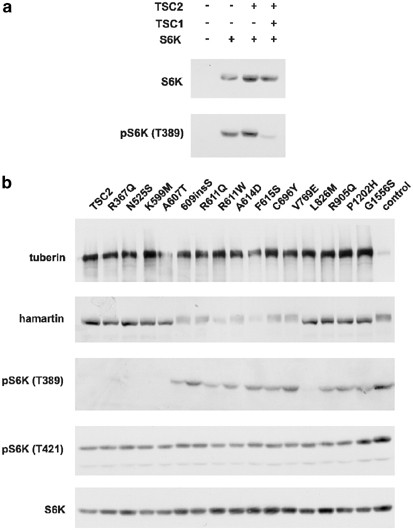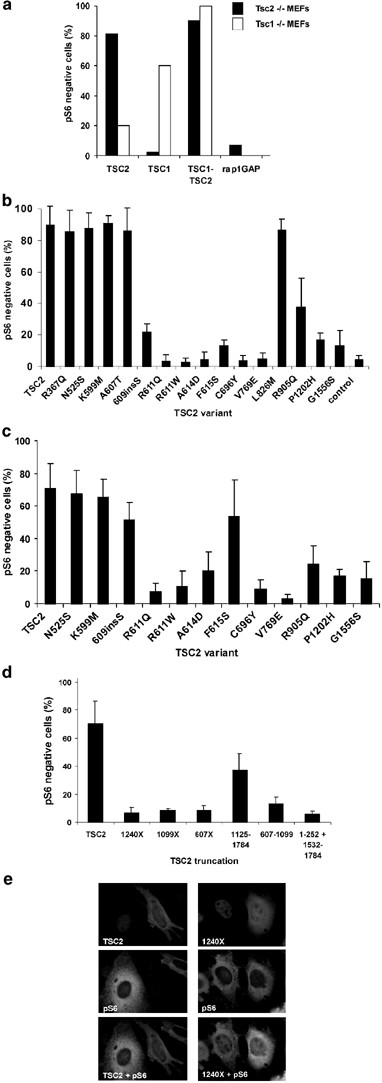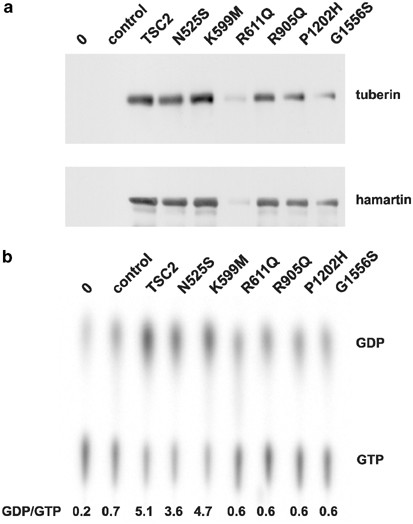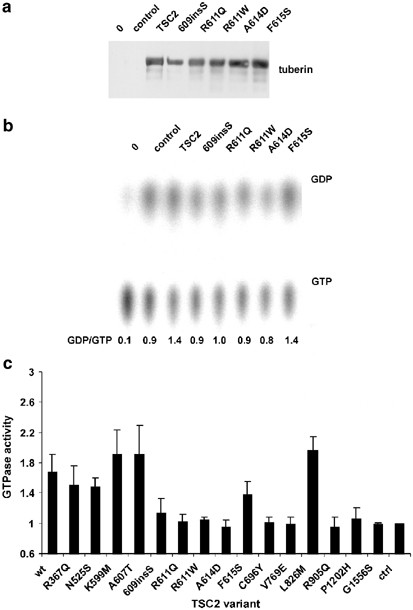Distinct effects of single amino-acid changes to tuberin on the function of the tuberin–hamartin complex (original) (raw)
Introduction
Tuberous sclerosis (TSC) is an autosomal dominant disorder caused by inactivation of either the TSC1 gene on chromosome 9q34 or the TSC2 gene on chromosome 16p13.3.1,2 TSC is characterised by the development of hamartomata in many tissues and organs. Brain and skin involvement results in the classic phenotype of seizures, mental retardation, and facial and ungual fibromas.3
The TSC1 and TSC2 gene products, hamartin and tuberin, interact to form a complex that inhibits cell growth by antagonising signal transduction through the mammalian target of rapamycin (mTOR).4 Inactivation of the tuberin–hamartin complex results in phosphorylation of the downstream effectors of mTOR, p70 S6 kinase (S6K), ribosomal protein S6 and the elongation factor binding protein 4E-BP1.5,6,7 The tuberin–hamartin complex antagonises mTOR through activation of the GTPase activity of rheb.8,9
In a mutation screen of 490 TSC patients, 22% of the pathogenic changes we identified were truncating TSC1 mutations (O Sancak, manuscript in preparation). We did not find any TSC1 missense mutations. In contrast, TSC2 missense mutations accounted for 15% of all the mutations detected in our cohort. In some cases, due to the unavailability of parental DNA and/or the lack of sufficient clinical data, we have not yet been able to determine whether specific missense changes are pathogenic. We are interested in characterising how missense changes affect tuberin function to help establish whether specific missense changes are pathogenic.
Previously, we found that the tuberin amino-acid substitutions R611Q, R611W, A614D, F615S, C696Y and V769E disrupted the interaction between tuberin and hamartin, destabilising the tuberin–hamartin complex and resulting in the loss of hamartin from preparations of cytosol. The R611Q, R611W, A614D, F615S, C696Y and V769E substitutions also prevented tuberin phosphorylation. In contrast, the N525S, K599M and R905Q substitutions did not affect the tuberin–hamartin interaction and did not prevent tuberin phosphorylation.10 We compared the effects of these substitutions and six additional amino-acid changes (R367Q, A607T, 609insS, L826M, P1202H and G1556S) on the tuberin–dependent phosphorylation of S6K and S6 and on the stimulation of the in vitro GTPase activity of rheb by tuberin.
Our analysis indicates that amino-acid changes have distinct effects on tuberin function. We show that some missense mutations outside the tuberin GAP domain completely inactivate the tuberin–hamartin complex, inhibiting the tuberin GAP activity and permitting phosphorylation of the downstream effectors of mTOR.
Materials and methods
Generation of constructs and antisera
Full-length TSC1 and TSC2 expression constructs have been described previously.11 Truncated TSC2 cDNAs encoding amino acids 1–1240 (Eco47III truncation), 1–1099 (_Xma_I truncation), 1–607 (_Nru_I truncation), 607–1099 and 1125–1784 (_Nru_I-_Xma_I fragments) and 1–252 plus 1536–1784 (_Sac_I internal in-frame deletion) were cloned behind an amino-terminal polyhistidine epitope tag derived from the pQE series of vectors (Qiagen) in the pSG5 expression vector. Expression constructs encoding the R367Q, N525S, K599M, A607T, 609insS, R611Q, R611W, A614D, F615S, C696Y, V769E, L826M, R905Q, P1202H and G1556S tuberin variants were derived by site-directed mutagenesis using the Stratagene QuickChange kit. All constructs were sequenced completely. Amino-acid residues are numbered according to reference 2.
An expression construct for the production of GST-rheb in bacteria was provided by M van Slegtenhorst (Fox Chase Cancer Center, Philadelphia, USA) and the 2B4 construct, encoding S6K, was provided by T Nobokuni (Friedrich Miescher Institute, Basel, Switzerland). Expression constructs encoding activated and dominant-negative isoforms of PKB were purchased from Upstate Biotechnology. The rap1GAP expression construct was obtained from Invitrogen.
Polyclonal rabbit antisera specific for human tuberin and hamartin have been described previously.11 Mouse monoclonal antibodies against the polyhistidine epitope tag were purchased from Qiagen. All other antibodies were purchased from Cell Signaling Technology.
Immunocytochemistry
The Tsc1 −/− and Tsc2 −/− mouse embryo fibroblasts (MEFs) were provided by H Onda (Brigham and Women's Hospital, Boston, USA;5,7). Transfections were performed using lipofectAMINE and PLUS reagent, as recommended by the supplier (Invitrogen). Growth medium was replaced with DMEM without additives 24 h after transfection and after 24 h of serum starvation, cells were fixed in 3% paraformaldehyde for 10 min and permeabilised with 0.2% Triton X-100 for 5 min. Antibodies against epitope-tagged tuberin or hamartin, and S6 or phosphorylated S6, were incubated with the coverslips overnight at 4°C. Finally, the coverslips were incubated with fluorescein isothiocyanate-coupled and Texas Red isothiocyanate-coupled secondary antibodies against mouse or rabbit immunoglobulins, respectively (both obtained from DAKO) and studied using a LeicaDM RXA microscope. In each experiment, at least 50 transfected cells were analysed per coverslip.
Immunoblotting and immunoprecipitation
Cells (6 cm dishes) were transfected using lipofectAMINE and PLUS reagent (Invitrogen). After 2 days, the cells were lysed in 0.5 ml TNE (50 mM Tris-HCl, pH 8.0, 150 mM NaCl, 50 mM NaF, 0.5 mM EDTA, 1% Triton X-100) for 10 min on ice and cleared by centrifugation at 10 000 g for 10 min at 4°C. Supernatants were analysed by SDS-PAGE followed by immunoblotting and enhanced chemiluminescence detection (Amersham).
For immunoprecipitations, 2 _μ_l of the appropriate antibody was added to 400 _μ_l of the supernatant and incubated on ice for 90 min before addition of 20 _μ_l of a 50% suspension of Protein A-Sepharose beads. After gentle rotation for 90 min at 4°C, the beads were washed with TNE, resuspended in Laemmli loading buffer and analysed by immunoblotting.
To analyse the phosphorylation of exogenous S6K, human embryonal kidney 293 cells (3.5 cm dishes) were cotransfected with 2B4, the S6K expression construct, and the TSC2 and TSC1 expression constructs. After 2 days, the cells were harvested directly in Laemelli loading buffer and analysed by immunoblotting.
In vitro assay of rheb GTPase activity
Recombinant GST-rheb was purified from Escherichia coli BL21 cells after induction with 0.5 mM isopropyl-B-D-thiogalactopyranoside for 2 h at 28°C. The bacteria were lysed in 50 mM Tris-HCl (pH 7.6), 1 mM DTT, 150 mM NaCl and 1% Triton X-100 containing 0.1 mg/ml lysozyme and, after sonication, GST-rheb (∼10 _μ_g) was purified on glutathione–agarose beads and incubated with 50 _μ_Ci [_α_32P]-GTP for 15 min at room temperature. After washing extensively with 20 mM Tris-HCl (pH 7.6), 10 mM MgCl2, 100 mM NaCl, 0.1 mg/ml BSA, 4 mM DTT to remove excess [_α_32P]-GTP, the GTP-bound GST-rheb was eluted in 100 _μ_l PBS containing 30 mM glutathione (pH 8.0).
Tuberin and hamartin were immunoprecipitated from 293 cells (6 cm dishes). Immunoprecipitates were washed twice with 500 _μ_l reaction buffer (20 mM Tris-HCl (pH 7.6), 10 mM MgCl2, 100 mM NaCl, 0.1 mg/ml BSA, 4 mM DTT), resuspended in 8 _μ_l reaction buffer and mixed gently at room temperature with 2 _μ_l of the eluted GST-rheb. At appropriate time points, 5 _μ_l of the reaction mixture supernatant was transferred to 2 _μ_l of dissociation buffer (150 mM EDTA, 5 mM GTP, 5 mM GDP, 50 mM DTT, 2% SDS) and incubated at 68°C for 10 min prior to loading 1 _μ_l on a PEI-cellulose thin-layer chromatography plate. Chromatography was performed in 0.75 M KH2PO4 (pH 3.4) and the plates scanned on a Molecular Dynamics phosphorimager. Signal intensity was calculated using the ImageQuant software package.
Results
We investigated the effects on tuberin function of 15 different amino-acid changes: R367Q, N525S, K599M, A607T, 609insS, R611Q, R611W, A614D, F615S, C696Y, V769E, L826M, R905Q, P1202H and G1556S. In previous work, we studied the effects of the N525S, K599M, R611Q, R611W, A614D, F615S, C696Y, V769E and R905Q substitutions on the tuberin–hamartin interaction, but not on the role of the proteins in the regulation of the mTOR signalling pathway.10 The G1556S substitution has recently been described elsewhere.12 The 609insS change (TSC2 1828insGCA) was identified in three affected members of a two generation TSC family and the P1202H substitution (TSC2 3623 C>A) was identified in a parent and child with TSC. The R367Q, A607T and L826M substitutions are nonpathogenic changes identified in unaffected relatives of TSC patients (Hodges et al13; O. Sancak, manuscript in preparation). The relative positions of the changes studied here are shown in Figure 1a.
Figure 1
Effects of single amino-acid changes on the tuberin–hamartin interaction. (a) Schematic diagram of tuberin indicating the relative positions of the 15 different amino-acid changes. The region of tuberin between amino acids 598 and 616 is shown in more detail. The positions of the K599M, A607T, 609insS, R611Q, R611W, A614D and F615S amino-acid changes are indicated. (b) Tuberin–hamartin complexes were immunoprecipitated with hamartin-specific antibodies from COS cells expressing exogenous hamartin, and tuberin (TSC2) or the R367Q, A607T or L826M variants. Hamartin and the tuberin variants were detected by immunoblotting. Mock-transfected cells were used as a control (control). (c) Hamartin, tuberin (TSC2) and the tuberin R611Q, 609insS and P1202H variants were overexpressed in COS cells. The expression of the proteins in the soluble fractions of the cell lysates was investigated by immunoblotting (lysate; left panel). Tuberin–hamartin complexes were immunoprecipitated with hamartin-specific antibodies (hamartin IP; right panel).
Effect of tuberin amino-acid changes on the tuberin–hamartin interaction
Previously, we demonstrated that the R611Q, R611W, A614D, F615S, C696Y and V769E substitutions disrupted the tuberin–hamartin interaction.10 Hamartin expression was reduced in the presence of these tuberin variants compared to the wild-type protein and tuberin and hamartin could not be coimmunoprecipitated. The G1556S substitution also destabilised the tuberin–hamartin interaction, although expression of the G1556S tuberin variant did not reduce hamartin expression in cytosol.12
The R367Q, A607T and L826M substitutions did not affect the tuberin–hamartin interaction. In each case, we were able to immunoprecipitate the tuberin–hamartin complex (Figure 1b). The 609insS tuberin variant had the same effect on the interaction as the R611Q, R611W, A614D, F615S, C696Y and V769E substitutions. As shown in Figure 1c, hamartin expression was reduced, and we were unable to coimmunoprecipitate hamartin and the 609insS tuberin variant. The P1202H substitution reduced, but did not prevent, coimmunoprecipitation of the tuberin–hamartin complex.
Single amino-acid changes affect the phosphorylation of tuberin by PKB
We coexpressed the tuberin variants with active and inactive PKB isoforms. As shown in Figure 2a, expression of active PKB resulted in the appearance of low mobility isoforms of the N525S, K599M, R905Q, P1202H and G1556S tuberin variants. As shown in Figure 2b, only these low mobility tuberin isoforms were recognised by an antibody specific for the phosphorylated PKB target sites on tuberin (Phospho-(ser/thr) akt substrate antibody; Cell Signaling Technology14). We did not detect phosphorylation of the PKB target sites of the 609insS, R611Q, R611W, A614D, F615S, C696Y and V769E variants and we concluded that these amino-acid changes inhibit the phosphorylation of tuberin by PKB.
Figure 2
Single amino-acid changes affect the phosphorylation of tuberin by PKB. (a) The tuberin variants and either an active isoform of PKB (+) or a dominant-negative PKB isoform (−) were coexpressed in COS cells and in each case, the electrophoretic mobility of tuberin was assayed by immunoblotting. (b) The tuberin variants and an active PKB isoform were coexpressed in COS cells. The tuberin variants were immunoprecipitated and their electrophoretic mobilities compared by immunoblotting (upper panel). Phosphorylated PKB target sites on the immunoprecipitated tuberin variants were detected with the phospho-(ser/thr) akt substrate antibody (Cell Signaling Technology) (lower panel).
Effect of tuberin amino-acid changes on the tuberin–dependent inhibition of S6K phosphorylation
We overexpressed tuberin, hamartin and S6K in human embryonal kidney 293 cells, and analysed S6K phosphorylation by immunoblotting. As shown in Figure 3a, coexpression of tuberin and hamartin inhibited phosphorylation of the linker domain (T389) of the exogenous S6K. Next, we investigated the effect of expression of the tuberin variants on S6K T389 phosphorylation. As shown in Figure 3b, equal levels of the tuberin variants were expressed but S6K T389 phosphorylation was only reduced in cells overexpressing wild-type tuberin or the R367Q, N525S, K599M, A607T and L826M tuberin variants. Phosphorylation of S6K within the pseudosubstrate region (T421/S424) was unaffected by overexpression of hamartin and the tuberin variants.
Figure 3
Effect of tuberin and hamartin on the phosphorylation of S6K. (a) S6K was overexpressed in 293 cells alone, with tuberin, or with tuberin and hamartin. Phosphorylation of the linker domain (T389) of the exogenous S6K was assayed by immunoblotting. (b) S6K and hamartin were overexpressed in 293 cells together with wild-type tuberin and the 15 tuberin variants. Cells overexpressing hamartin and S6K only were included as a control (control). Expression of hamartin, S6K and the different tuberin variants, as well as the phosphorylation status of the overexpressed S6K was analysed by immunoblotting. Wild-type tuberin and the R367Q, N525S, K599M, A607T and L826M tuberin variants inhibited T389 phosphorylation of S6K but not T421/S424 phosphorylation. The 609insS, R611Q, R611W, A614D, F615S, C696Y, V769E, R905Q, P1202H and G1556S did not affect S6K phosphorylation.
The expression of hamartin was also dependent upon coexpression of the tuberin variants. A broad, diffuse band was detected when hamartin was expressed alone, or in the presence of the 609insS, R611Q, R611W, A614D, F615S, C696Y and V769E tuberin variants that do not form a complex with hamartin. This could be due to either increased ubiquitination15 or phosphorylation16 of hamartin when it is not bound to tuberin.
Effect of tuberin amino-acid changes on the inhibition of S6 phosphorylation in Tsc2 −/− MEFs
After serum-starvation, the downstream effectors of mTOR (S6K, S6 and 4E-BP1) are phosphorylated in cells lacking either tuberin or hamartin, but not in wild-type cells.5,6,7 We expressed tuberin and hamartin in Tsc2 −/− and Tsc1 −/− MEFs and assayed the phosphorylation of S6 in transfected, serum-starved cells by double-label immunofluorescent microscopy, as described previously by others.6,17 Transfected cells expressing either tuberin or hamartin, with a clear reduction in S6 phosphorylation, were counted ‘blind’ by two independent observers. Approximately 80% of the Tsc2 −/− MEFs expressing exogenous tuberin and approximately 60% of the Tsc1 −/− MEFs expressing exogenous hamartin had no detectable phosphorylated S6 (pS6), compared to less than 10% of control cells. We concluded that the inhibition of S6 phosphorylation in the Tsc2 −/− and Tsc1 −/− MEFs was due to the exogenous expression of tuberin and hamartin, respectively. Expression of both tuberin and hamartin together was more effective than expression of either protein alone; pS6 was detected in less than 20% of the transfected cells.
Next, we investigated whether coexpression of hamartin and the tuberin variants inhibited S6 phosphorylation in the Tsc2 −/− MEFs, and whether expression of the tuberin variants alone was sufficient to inhibit S6 phosphorylation. As shown in Figure 4b, in cells expressing hamartin and the R367Q, N525S, K599M, A607T and L826M tuberin variants pS6 was not detected in approximately 90% of the transfected cells. There was no significant difference between wild-type tuberin and the R367Q, N525S, K599M, A607T and L826M variants in this assay (paired _t_-test _P_>0.05 in each case). In contrast, pS6 was detected in significantly more of the cells expressing the 609insS, R611Q, R611W, A614D, F615S, C696Y, V769E, R905Q, P1202H, and G1556S tuberin variants (paired _t_-test P<0.05 compared to wild-type tuberin in each case). These are the same amino-acid changes that prevented the tuberin–dependent inhibition of S6K T389 phosphorylation in the human 293 cells.
Figure 4
Tuberin and hamartin-dependent inhibition of S6 phosphorylation in Tsc1 −/− and Tsc2 −/− MEFs. (a) Tsc1 −/− (open bars) and Tsc2 −/− (solid bars) MEFs were transfected with expression constructs encoding myc-tagged hamartin (TSC1), polyhistidine-tagged tuberin (TSC2), both proteins (TSC1-TSC2) or V5-tagged rap1GAP. After serum starvation, double-label immunofluorescent microscopy was performed to assess S6 phosphorylation in the transfected cells. Phosphorylated S6 was detected using the phospho-S6 (S235/236) antibody from Cell Signaling Technology; the exogenous proteins were detected using antibodies against the different epitope tags. Cells expressing the exogenous proteins with detectable pS6 (no inhibition) or without detectable pS6 (inhibition) were counted. In each case, at least 50 cells were counted per transfection. The percentages of transfected cells expressing exogenous proteins and without detectable pS6 are indicated (pS6-negative cells). (b) Tsc2 −/− MEFs were cotransfected with expression constructs encoding epitope-tagged hamartin and tuberin (TSC2), as before, and 15 epitope-tagged tuberin variants (R367Q, N525S, K599M, A607T, 609insS, R611Q, R611W, A614D, F615S, C696Y, V769E, L826M, R905Q, P1202H, and G1556S). After serum starvation, double-label immunofluorescent microscopy was performed to detect pS6 in the transfected cells, as described in (4a). The analysis was repeated five times. The mean values for the proportion of transfected MEFs without detectable pS6 are shown (pS6-negative cells). The proportion of MEFs overexpressing rap1GAP without detectable pS6 is also shown (control). (c) Tsc2 −/− MEFs were transfected with expression constructs encoding epitope-tagged tuberin (TSC2) and 12 pathogenic epitope-tagged tuberin variants (N525S, K599M, 609insS, R611Q, R611W, A614D, F615S, C696Y, V769E, R905Q, P1202H, and G1556S). After serum starvation, double-label immunofluorescent microscopy was performed to detect pS6 in the transfected cells, as described in (4b). (d) Tsc2 −/− MEFs were transfected with expression constructs encoding epitope-tagged tuberin (TSC2) and truncated tuberin proteins (1240X, 1099X, 607X, 1125–1784, 607–1099 and 1-252+1532–1784). After serum starvation, double-label immunofluoresent microscopy was performed to detect pS6 in the transfected cells, as described in (4b). (e) Representative examples of the inhibition of S6 phosphorylation in Tsc2 −/− MEFs. Cells expressing epitope-tagged wild-type tuberin (TSC2) and a tuberin truncation protein (1240X) are shown in the top left and top right panels, respectively. Phosphorylated S6 (pS6) in the same cells is shown in the central panels and the bottom left and bottom right panels show the combined images. Phosphorylated S6 is not detectable in the cell expressing wild-type tuberin (left), unlike in the cell expressing the 1240X truncation protein (right) or the untransfected cells (both panels).
As shown in Figure 4c, expression of the tuberin variants alone (without hamartin) in the Tsc2 −/− MEFs had slightly different effects on S6 phosphorylation. In approximately 70% of the Tsc2 −/− MEFs expressing wild-type tuberin and the N525S and K599M tuberin variants, pS6 was not detectable, while in cells expressing the R611Q, R611W, A614D, C696Y, V769E, R905Q, P1202H and G1556S variants, pS6 was detected in <30% of the transfected cells (paired _t_-test _P_<0.05 in each case). Surprisingly however, in approximately half the cells expressing the tuberin 609insS and F615S variants, S6 phosphorylation was reduced. This was not significantly different to wild-type tuberin (paired _t_-test _P_>0.05 in each case) and suggested that the 609insS and F615S amino-acid changes did not inactivate the tuberin–dependent inhibition of S6 phosphorylation completely.
Effect of tuberin truncation on the inhibition of S6 phosphorylation in Tsc2 −/− MEFs
We investigated whether expression of a specific tuberin domain would be sufficient to inhibit S6 phosphorylation in Tsc2 −/− MEFs. As shown in Figure 4d, pS6 was detected in 90% of the Tsc2 −/− MEFs expressing the 607X (amino acids 1–607), 1099X (amino acids 1–1099) and 1240X (amino acids 1–1240) N-terminal domains of tuberin, a central domain of tuberin (amino acids 607–1099), or an in-frame deletion protein (amino acids 1–252 plus 1532–1784). In contrast, pS6 was detected in only 60% of the cells expressing the tuberin C-terminal domain (amino acids 1125–1784). This difference was significant (paired _t_-test P<0.05), indicating that expression of the tuberin C-terminal domain was sufficient to inhibit S6 phosphorylation in Tsc2 −/− MEFs, although less effectively than full-length tuberin.
Effect of tuberin amino-acid changes on rheb GTPase activity in vitro
To investigate whether the tuberin amino-acid changes affected the rhebGAP activity of the tuberin–hamartin complex directly, we assayed the rhebGAP activity of the complex in vitro. Tuberin and myc epitope-tagged hamartin were coexpressed in 293 cells and tuberin–hamartin complexes immunoprecipitated with antibodies specific for the myc epitope, as shown in Figure 5a. As shown in Figure 5b, immunoprecipitates of the wild-type complex increased the rheb GTPase activity compared to immunoprecipitates from untransfected cells, or cells expressing exogenous hamartin only. Immunoprecipitates of hamartin with the tuberin N525S and K599M variants caused a similar increase in rheb GTPase activity. In contrast, immunoprecipitates from cells expressing the R611Q, R905Q, P1202H and G1556S variants did not increase the rheb GTPase activity above control levels.
Figure 5
Effect of tuberin–hamartin complexes on in vitro rheb GTPase activity. Tuberin–hamartin complexes were immunoprecipitated from 293 cells with an antibody against the hamartin myc epitope tag and incubated with GST-rheb preloaded with [_α_-32P]GTP. GTP and GDP were resolved by thin-layer chromatography and the GTP:GDP ratio determined by phosphoimaging. After the GTPase assay, the immunoprecipitates were analysed by immunoblotting. Each tuberin variant was assayed at least 3 times. (a) Immunoblot of the immunoprecipitated tuberin–hamartin complexes used for the assay of rheb GTPase activity shown in (b). (b) Representative example of in vitro rheb GTPase activity measured in the presence of tuberin–hamartin complexes. The GDP:GTP ratios after incubation with the immunoprecipitates from untransfected cells (0), from cells overexpressing hamartin only (control), and from cells overexpressing hamartin and wild-type tuberin (TSC2), or the N525S, K599M, R611Q, P1202H and G1556S variants, are shown.
Some reports suggest that hamartin is necessary for the optimal GAP activity of tuberin.18,19,20 However, other studies found that hamartin was not required for the stimulation of rheb GTPase activity by tuberin.21,22 To investigate whether the R367Q, N525S, K599M, 609insS, R611Q, R611W, A614D, F615S, C696Y, V769E, L826M, R905Q, P1202H and G1556S amino-acid changes affected the GAP activity of tuberin, the variants were overexpressed in 293 cells and immunoprecipitated with antibodies specific for tuberin. As shown in Figure 6a, equal amounts of the variants were immunoprecipitated. The wild-type tuberin immunoprecipitate caused a modest increase in rheb GTPase activity compared to the control immunoprecipitate of endogenous tuberin (Figure 6b). The R367Q, N525S, K599M, A607T, 609insS, F615S and L826M tuberin variants also increased the rheb GTPase activity. In contrast, the R611Q, R611W, A614D, C696Y, V769E, R905Q, P1202H and G1556S tuberin variants were unable to stimulate rheb GTPase activity above the control value (Figure 6c).
Figure 6
Effect of the tuberin variants on in vitro rheb GTPase activity. Immunoprecipitated tuberin variants were incubated with GST-rheb preloaded with [_α_-32P]GTP. GTP and GDP were resolved by thin-layer chromatography and the immunoprecipitates were analysed by immunoblotting. Each tuberin variant was assayed at least 3 times. (a) Immunoblot analysis of the immunoprecipitated tuberin variants used for the rheb GTPase activity assay shown in (b). (b) Representative example of an in vitro rheb GTPase assay in the presence of tuberin and the tuberin 609insS, R611Q, R611W, A614D and F615S variants. The GDP:GTP ratios after incubation with protein A beads only (0), from untransfected cells (control), and from cells overexpressing wild-type tuberin (TSC2), or the 609insS, R611Q, R611W, A614D and F615S variants, are shown. (c) GTPase activity of GST-rheb in the presence of the tuberin R367Q, N525S, K599M, A607T, 609insS, R611Q, R611W, A614D, F615S, C696Y, V769E, L826M, R905Q, P1202H and G1556S variants. The fold differences in the GTP:GDP ratio in the presence of exogenous wild-type tuberin and tuberin variants compared to endogenous tuberin (control) are shown. Each tuberin variant was tested at least three times.
Discussion
We compared tuberin to 15 variants, each differing from the wild-type protein by a single amino-acid change. Three substitutions, R367Q, A607T and L826M, were identified in individuals without TSC and served as additional positive controls for tuberin activity. The K599M, R611Q, R611W, A614D, V769E and R905Q substitutions were originally identified as de novo changes in sporadic TSC patients.10 The N525S, 609insS, P1202H and G1556S changes were identified in familial cases of TSC and cosegregated with the disease. The F615S and C696Y substitutions were also identified in TSC patients, although in these cases, DNA analysis of the parents could either not be performed, or could not establish whether the identified change was pathogenic.10
We investigated the effects of the amino-acid changes on the tuberin–hamartin complex, tuberin phosphorylation, S6K phosphorylation and S6 phosphorylation. Finally, we assayed the effects of the changes on the in vitro stimulation of rheb GTPase activity by tuberin and the tuberin–hamartin complex. Our results are summarised in Table 1.
Table 1 Comparison of the effects of amino-acid changes on tuberin function. Scores according to the BLOSUM 62 matrix25 are indicated
Consistent with the identification of the R367Q, A607T and L826M substitutions in individuals without TSC, these changes did not adversely affect the tuberin–hamartin interaction, the stimulation of rheb GTPase activity or the inhibition of S6K and S6 phosphorylation. There was no evidence that the R367Q, A607T and L826M substitutions disrupted tuberin function and we concluded that they are nonpathogenic changes.
The R611Q, R611W, A614D, C696Y and V769E substitutions disrupted the tuberin–hamartin interaction, and prevented the phosphorylation of tuberin by PKB, the inhibition of S6 and S6K phosphorylation, and the stimulation of rheb GTPase activity. All five substitutions inactivated tuberin completely in all our assays. We concluded that the R611Q, R611W, A614D, C696Y and V769E substitutions cause TSC because they result in major conformational changes to tuberin.
The 609insS and F615S amino-acid changes disrupted the tuberin–hamartin interaction, prevented phosphorylation of tuberin by PKB and prevented the inhibition of S6K phosphorylation. However, overexpression of the 609insS and F615S variants reduced S6 phosphorylation to almost the same extent as wild-type tuberin when overexpressed (in the absence of overexpressed hamartin) in Tsc2 −/− MEFs, suggesting that the 609insS and F615S changes do not completely inactivate tuberin. The inability to form a stable complex with hamartin explains why the 609insS and F615S variants were less effective at inhibiting S6 phosphorylation in the cotransfection experiments (Figure 4b) than when overexpressed alone (Figure 4c). Interestingly, overexpression of the tuberin C-terminal domain in the Tsc2 −/− MEFs, also reduced S6 phosphorylation in some cells, consistent with the suggestion that the tuberin C-terminal GAP domain is critical for tuberin activity.23,24 Our data suggest that the 609insS and F615S substitutions prevent tuberin activity in vivo because tuberin cannot be stabilised by the interaction with hamartin. The rheb GTPase activity measured in the presence of the 609insS and F615S variants was intermediate between the wild-type protein and the control values, suggesting that the 609insS and F615S variants retain some rhebGAP activity, consistent with the partial inhibition of S6 phosphorylation in the Tsc2 −/− MEFs.
The R905Q, P1202H and G1556S substitutions did not prevent formation of the tuberin–hamartin complex, or the PKB-dependent phosphorylation of tuberin. However, the R905Q, P1202H and G1556S tuberin variants did not inhibit S6K phosphorylation in 293 cells, were less effective than wild-type tuberin at inhibiting S6 phosphorylation in the Tsc2 −/− MEFs, and were unable to stimulate rheb GTPase activity. Our analysis indicates that although the R905Q, P1202H and G1556S substitutions do not prevent the formation of the tuberin–hamartin complex or tuberin phosphorylation, none of these variants increased the GTPase activity of rheb or inhibited S6 and S6K phosphorylation.
The N525S and K599M substitutions did not affect either the tuberin–hamartin interaction or tuberin phosphorylation.10 Both variants inhibited the phosphorylation of S6K and S6, and increased the GTPase activity of rheb. We were unable to differentiate between wild-type tuberin and the N525S and K599M variants. Analysis of the respective nucleotide substitutions (TSC2 1292A>G and TSC2 1814A>T) with three different splice site prediction programs (http://www.genet.sickkids.on.ca/ali-cgi-bin/splicesitefinder; http://www.cbs.dtu.dk/cgi-bin/nph-webface?jobid=netgene2 and http://www.fruitfly.org/cgi-bin/seq_tools/splice.pl) indicated that the mutations were unlikely to affect splicing of the TSC2 transcript. As shown in Table 1, the N525S substitution had a neutral score in the BLOSUM 62 matrix25 and was found to cosegregate with TSC in an affected family.26 It is possible that this amino-acid change cosegregates with another (unidentified) TSC2 mutation. Our analysis does not support the finding that the N525S substitution is a pathogenic mutation. The K599M substitution is a de novo mutation26 and has been shown to reduce the tuberin–dependent inhibition of phosphorylation of overexpressed 4E-BP1.27 However, this effect is weak compared to the V769E tuberin variant.28 Our analysis is consistent with the K599M substitution having a weak effect on tuberin function and it will be interesting to determine whether this mutation is associated with a mild TSC phenotype. It is possible that more sensitive assays will be required to distinguish some tuberin mutants from the wild-type protein. One way to do this would be to (stably) express endogenous levels of these variants in tuberin–deficient cells.
Our study indicates that nontruncating TSC2 mutations can have distinct effects on tuberin function. It remains to be shown, however, whether these differences will correlate with differences in the phenotypes of TSC patients. In an earlier study, no evidence for a correlation between missense mutations to the tuberin GAP domain and a severe TSC phenotype was found.29 Our study supports these findings. Amino-acid substitutions outside the GAP domain were sufficient to completely inactivate tuberin.
In summary, we have investigated the effects of pathogenic and nonpathogenic amino acid changes on tuberin function. We analysed the effect of the changes on the tuberin–hamartin interaction, on the phosphorylation of tuberin by PKB, and on the tuberin–dependent inhibition of S6 phosphorylation. Amino-acid changes to the central region of tuberin inactivated tuberin completely. Our data show that this central domain is necessary for formation of the tuberin–hamartin complex and indicates that missense mutations outside the tuberin GAP domain can completely inactivate the complex.
